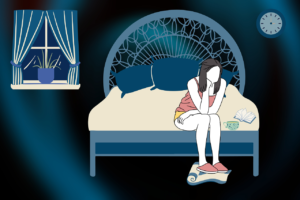
Are You Working Overtime at Night?
First Sleep, Second Sleep, and “The Watch”
Do you wake up at night? Do you have to eat a snack, drink some milk, or read a book to return to sleep? According to the Cleveland Clinic, one in three adults worldwide have insomnia symptoms (30% in the U.S.)
The NHSinform (National Health Service of Scotland) lists the following as common causes of insomnia: stress, anxiety, poor sleep environment (uncomfortable bed, too much light, noise, too hot or cold, alcohol, caffeine, and change in work hours).
But, have you ever considered that the cause may be “The Watch?” A forgotten medieval habit of sleeping in two shifts, once in the evening and once in the morning (“first sleep” and “second sleep”), included a period of wakefulness and activity in between – “the watch.” This unusual phenomenon of double sleeping, or “biphasic sleep” was common in England and Europe (and other societies around the globe) during the Middle Ages and until the industrial revolution.
The watch followed a period of sleep of usually about two hours, and lasted typically from 11:00 pm to 1:00 am. “This period of wakefulness was a surprisingly useful window in which to get things done. People did just about anything and everything after they awakened from their first sleep… from tending to ordinary tasks, such as adding wood to the fire, taking remedies, or going to urinate (often into the fire itself).
“For peasants, waking up meant getting back down to more serious work – whether this involved venturing out to check on farm animals or carrying out household chores.
“The watch was also a time for religion,” with specific prayers for exact time periods.
“But most of all, the watch was useful for socializing – and for sex.”
And, not unexpectedly, “criminals took the opportunity to skulk around and make trouble.”
So, is there any evidence that this is a normal circadian pattern?
In the early 1990s, a study by Thomas Wehr experimented with shortening men’s hours of light exposure to only ten hours per day, with fourteen hours confined to a dark room. After four weeks, the men were sleeping in a divided pattern of two halves with one to three hours in between of wakefulness. Wehr had reinvented biphasic sleep.
Another study, in 2015, involved volunteers from a remote area in Madagascar that had no electricity and no lights at night. The volunteers wore an “actimeter” that could track sleep cycles for ten days. The researchers found that subjects with no artificial light had a period of activity from about midnight until 1:00 or 1:30, then would fall back to sleep until 6:00 a.m. and sunrise.
Why has this pattern of biphasic sleep disappeared?
Actually, it still exists in small areas of the world, but the evidence seems to point to the Industrial Revolution, with artificial lighting as the cause for the end of biphasic sleep.
But, do some of us maintain a hidden need for a natural sleep pattern? Is it possible that our modern lifestyle and pattern of sleep is not what our bodies and brain really crave?
Do you have insomnia? Does it occur at a specific time? How long does it usually last?
What do you do to get back to sleep?
Do you make use of this time for writing or reading?
Have you found a book you would like to nominate for most likely to make you sleepy?

